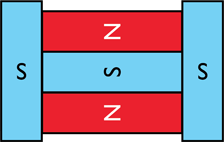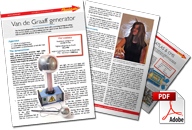Superconductivity
The sight of a chunk of superconductor floating serenely over some super-strong magnets is a genuine wow moment in the show. These amazing materials are used to create the enormous magnetic fields used to control the beam in the LHC.
Apparatus
5 × neodymium-iron-boron magnets (their poles are on their faces: arrange them as shown)
1 × piece of high-temperature superconductor
1 × polystyrene cup, 2/ 3 full of liquid nitrogen
1 × plastic tweezers
The demonstration
- Using the plastic tweezers, lower the superconductor into the polystyrene cup of nitrogen. It will bubble fiercely. Depending on your piece of superconductor, this may take some time, so having some patter ready about the nitrogen boiling and sucking the heat out of the superconductor is advisable.
- When the boiling stops, pull the superconductor out of the nitrogen again using the tweezers, and lower it vertically onto the five magnets. When you release the tweezers, it will just continue to float there!
- When the superconductor warms above its critical temperature, it will fall onto the magnets. Place it back into the nitrogen with the tweezers. Being so cold, it should cool down rather more quickly this time. Repeat!
Arrangement of magnets

The arrangement of the magnets to allow stable superconducting levitation. Note that absolute polarity is not important!
How it works
Superconductors are materials which display very unusual properties when cooled down below their critical temperature: chief amongst them, as implied by their name, they suddenly lose all electrical resistance.
Related to this vanishing resistance is the effect on display here: the Meissner effect, where a superconductor excludes all magnetic flux from inside its volume. This is because it costs no energy to induce a supercurrent inside the superconductor and, when brought near a magnet, that current will be set up by Lenz’s law to oppose the change causing it. Consequently, the superconductor acts something like a magnetic mirror, creating an image of the same magnetic pole as it’s brought near, and repelling it. This allows it to defy gravity, and levitate.
The reason we need multiple magnets is that when levitated over a single magnet, the superconductor is in an unstable equilibrium: the more complex configuration of fields over the arrangement of magnets suggested means that there’s a stable position over them, and the superconductor will even spring back if displaced slightly.
This effect isn’t exactly what we use in the LHC, though it does implicitly demonstrate the zero electrical resistance which is used. It’s also not this type of superconductor which is used in the LHC. This demo relies on so-called ‘high-temperature’ superconductors which can superconduct at liquid nitrogen temperatures. These superconductors are brittle, layered materials which don’t lend itself to extrusion into long wires so niobium–titanium, a superconducting alloy, is used instead, and cooled by liquid helium to a temperature of just 1.9 K (−271°C).



